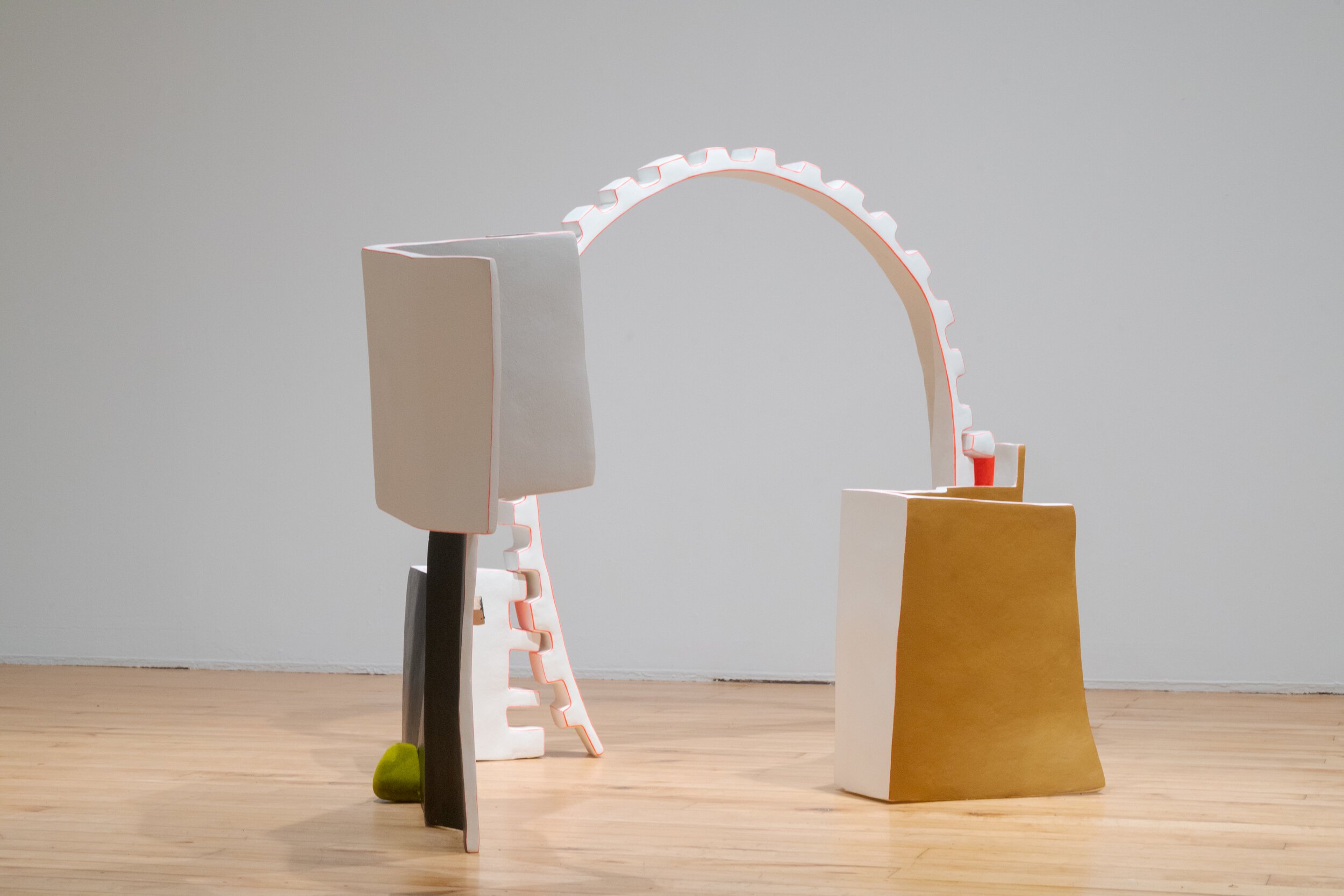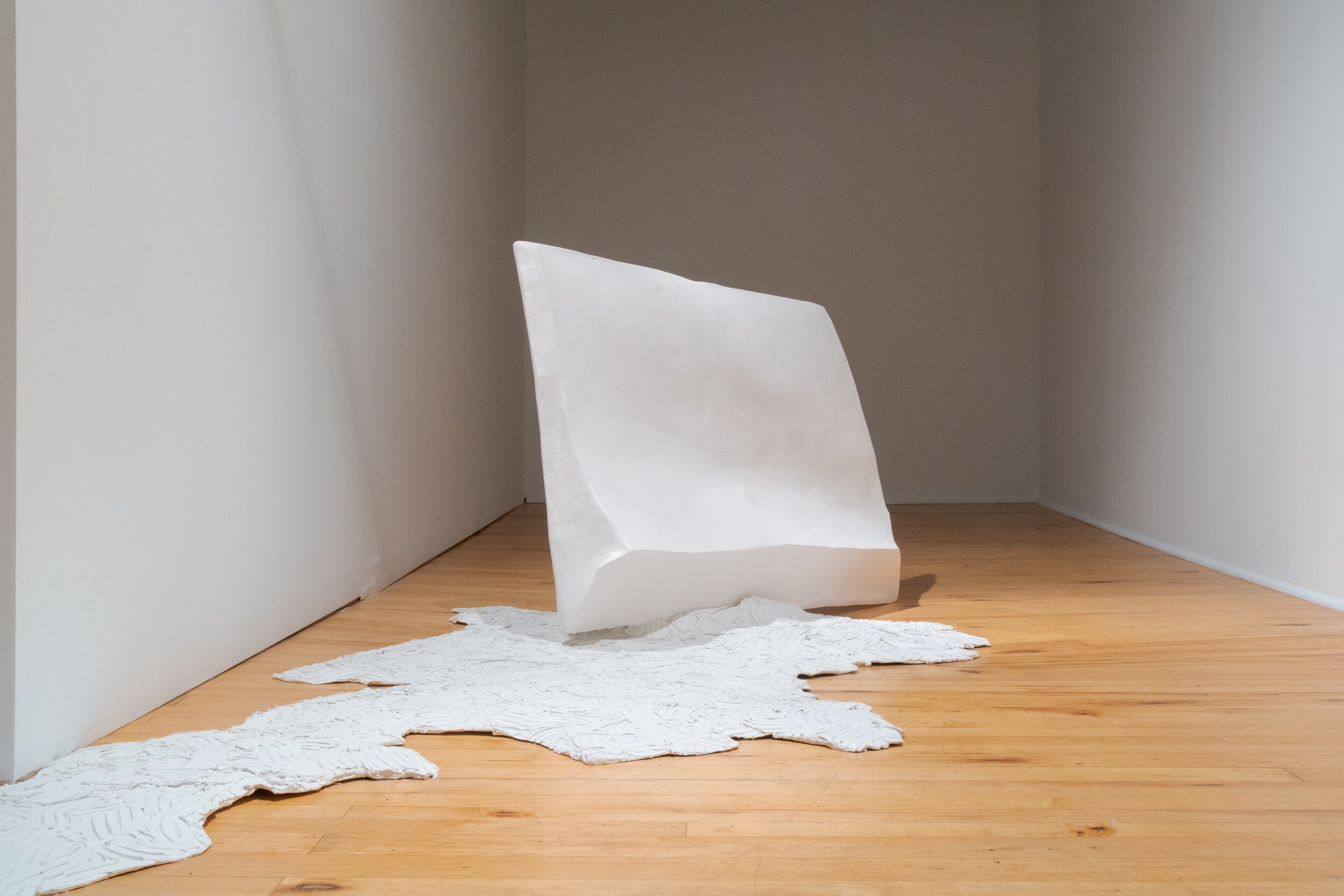Rebecca Wing at Big Orbit Project Space
by Nando Alvarez-Perez
Rebecca Wing, Vehicularish, 2019. Installation view. Photo: Nando Alvarez-Perez
Plows, gears, steamrollers, tanks, and moon landers–heavy, metallic, manly things–are softened, sheathed in white, turned naked and vulnerable, and brought into precarious new arrangements with one another in Rebecca Wing’s exhibition, Vehicularish, at Big Orbit Project Space. The five sculptures on view share a small palette of modest materials, like papier-mâché clay, wood, paint, and cardboard, and move confidently from the intimate to the monumental with subtlety and humor.
Lander (2019), the first work the viewer encounters in the space, feigns space-agey ambition but looks more like a white, handmade pickup truck camper shell propped against–almost mounting–a neon pink disc partially covered in preserved moss. Bend over to look under the piece and you’ll see the inside of the shell is painted a luminous yellow. Bodily prompts and associations abound through these sculptures—they lean and slump, they somehow look like they’re gazing at their shoes, they inspire sympathy in their saggy honesty.
Rebecca Wing, 2 Roads, 2019. Photo: Nando Alvarez-Perez
2 Roads (2019) is the most visually dynamic work in Vehicularish. Spindly walls at knee-height, perhaps the titular roads as seen from above, stretch out from a tall, white, squishy-looking mechanical gear made from papier-mâché clay and cardboard. It resembles a mechanically driven Möbius strip, snipped in half and flailing. One wall, painted black on the outside and white inside, bisects a small, green, flocked rock and transforms it into a side-eyed, microcosmic view of Michael Heizer’s monumental earthwork, Double Negative (1969). Like so many of the details in Vehicularish, the gesture is a small but visually striking moment in a work whose formal connotations (the churning gear, the cut Möbius strip that now resembles broken open walls) lend it historical significance.
The largest work in the exhibition, Roller Tank (2018–19), is a sort of frozen steamroller in two parts—a ramp or wedge attached by plywood arms to a cylinder, both white and edged with neon yellow—with just a spidery whiff of Louise Bourgeois’s epic Maman (1999). The steamroller’s capacity for flattening is neutered here by its apparent immobility. Although the triangular, naked plywood forms that hold the piece together lend it a dramatic verticality–it is the only work in the exhibition that can be walked under–they seem less attended to than so many of the details in other works.
Despite its formal simplicity, especially as compared with the visual hijinks put to use in most of the other sculptures, Plow (2019) is the work that has most stuck with me. An abstracted white snowplow with a papier-mâché clay surface and softened edges painted a faint and shimmering lavender delicately plows into a puddle of joint compound on the floor. Plow invokes not just a snowy accident but also notions of feminine resilience and, rather remarkably, of world peace–from one angle the plow form looks like a three-dimensional extrusion of the bent sword in Yevgeny Vuchetich’s epic sculpture, Let Us Beat Swords into Ploughshares (1959). The sentiment would risk feeling naive if our current political moment were any less demanding of its earnestness.
Rebecca Wing, Plow, 2019. Photo: Nando Alvarez-Perez.
Wing’s sculptures, well versed in blurring dichotomies of hard/soft, natural/synthetic, inside/outside, representation/abstraction, weight/lightness, and strength/vulnerability, fit into a history of sculpture made by women, bringing to mind not just the canonical (Lynda Benglis, Eva Hesse, Jessica Stockholder, etc.) but also contemporaries like Meg Lipke, recently on view at the UB Art Galleries, and Stephanie Rohlfs, who exhibited at Hallwalls Contemporary Arts Center this past spring. They are works freighted with history and historical reference, burdened at times by the past, but plowing a path into the future.
Nando Alvarez-Perez is an artist and teacher and the co-founder of The Buffalo Institute for Contemporary Art and Cornelia.




